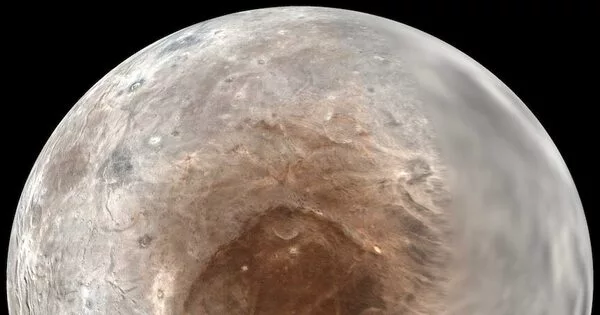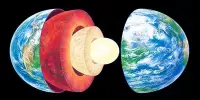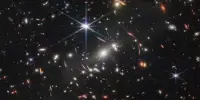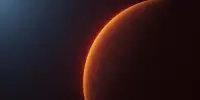Scientists used data from NASA’s New Horizons mission, as well as novel laboratory experiments and exospheric modeling, to determine the likely composition and formation of the red cap on Pluto’s moon Charon. This first-ever depiction of Charon’s dynamic methane atmosphere based on fresh experimental data offers an intriguing peek into the origins of this moon’s red patch, as described in two recent papers.
Southwest Research Institute scientists used data from NASA’s New Horizons mission, as well as unique laboratory experiments and exospheric modeling, to determine the likely composition and formation of the red cap on Pluto’s moon Charon. This first-ever description of Charon’s dynamic methane atmosphere using new experimental data provides a fascinating glimpse into the origins of this moon’s red spot as described in two recent papers.
“Prior to New Horizons, the best Hubble images of Pluto revealed only a fuzzy blob of reflected light,” said SwRI’s Randy Gladstone, a member of the New Horizons science team. “In addition to all the fascinating features discovered on Pluto’s surface, the flyby revealed an unusual feature on Charon, a surprising red cap centered on its north pole.”
Our findings indicate that drastic seasonal surges in Charon’s thin atmosphere as well as light breaking down the condensing methane frost are key to understanding the origins of Charon’s red polar zone. This is one of the most illustrative and stark examples of surface-atmospheric interactions so far observed at a planetary body.
Dr. Ujjwal Raut
Soon after the 2015 flyby, New Horizons scientists speculated that a reddish “tholin-like” substance at Charon’s pole could be created by breaking down methane molecules with ultraviolet light. These are collected after escaping from Pluto and then frozen onto the polar regions of the moon during their long winter months. Tholins are sticky organic residues created by light-powered chemical processes, in this case the Lyman-alpha ultraviolet glow scattered by interplanetary hydrogen molecules.
“Our findings indicate that drastic seasonal surges in Charon’s thin atmosphere as well as light breaking down the condensing methane frost are key to understanding the origins of Charon’s red polar zone,” said SwRI’s Dr. Ujjwal Raut, lead author of a paper titled “Charon’s Refractory Factory” in the journal Science Advances. “This is one of the most illustrative and stark examples of surface-atmospheric interactions so far observed at a planetary body.”
The team realistically replicated Charon surface conditions at SwRI’s new Center for Laboratory Astrophysics and Space Science Experiments (CLASSE) to measure the composition and color of hydrocarbons produced on Charon’s winter hemisphere as methane freezes beneath the Lyman-alpha glow. The team fed the measurements into a new atmospheric model of Charon to show methane breaking down into residue on Charon’s north polar spot.
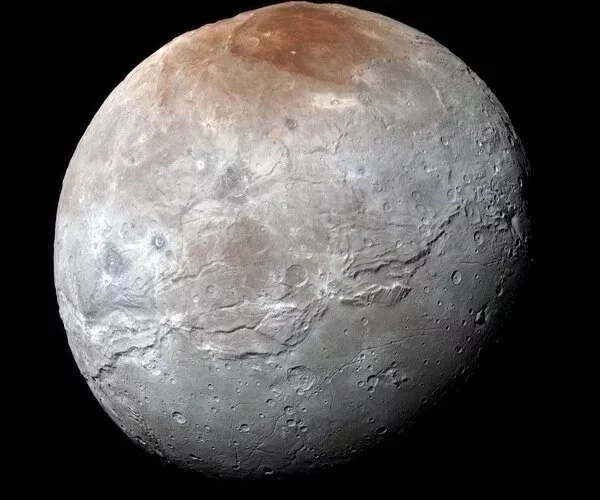
“Our team’s novel ‘dynamic photolysis’ investigations established new constraints on the contribution of interplanetary Lyman-alpha to Charon’s red material production,” Raut added. “Our experiment condensed methane in an ultra-high vacuum chamber while exposed to Lyman-alpha photons to reproduce the circumstances at Charon’s poles with high fidelity.”
SwRI researchers have created a new computer simulation to simulate Charon’s scant methane atmosphere. “The model predicts ‘explosive’ seasonal pulsations in Charon’s atmosphere due to extreme shifts in conditions during Pluto’s long journey around the Sun,” said Dr. Ben Teolis, lead author of a related paper published in Geophysical Research Letters titled “Extreme Exospheric Dynamics at Charon: Implications for the Red Spot.”
The team used the results of SwRI’s ultra-realistic experiments to estimate the distribution of complex hydrocarbons emitted by methane decomposition under the impact of UV light. The model includes polar zones that largely produce ethane, a colorless substance that does not contribute to the reddish hue.
“We believe that ionizing radiation from the solar wind decomposes the Lyman-alpha-cooked polar frost to synthesis increasingly complex, redder compounds responsible for this intriguing moon’s peculiar albedo,” Raut explained. “Ethane is less volatile than methane and remains frozen to the surface of Charon well after the spring daybreak. Ethane may be converted into persistent reddish surface deposits as a result of exposure to the solar wind, contributing to Charon’s red cap.”
“The team is ready to examine the role of solar wind in the development of the red pole,” stated SwRI’s Dr. Josh Kammer, who has received ongoing funding from NASA’s New Frontier Data Analysis Program.
